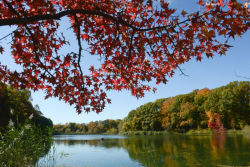Alley Pond Park
The Forests of New York City - Alley Pond Park
There are roughly 1,000 acres of forest in Queens, which are divided almost evenly between Forest, Cunningham, and Alley Pond Parks. All three parks are on the terminal moraine, the ridge that marks the furthest advance of a glacier, and share the knob and kettle topography; rounded hills (knobs) alternating with bowl-shaped depressions (kettles) typical of these landscapes. Queens’s parks also have in common the forest types that are typical of terminal moraine landscapes: dry oak-hickory forests on the knobs, rich forests in the kettles, and often red maple-hardwood swamps when kettle ponds are present.
Alley Pond Park’s forests range from oak-hickory forests dominated by dry, white oak (Quercus alba) on top of knobs, to red maple-hardwood swamps in a series of kettle ponds. In between are moist oak-hickory forests with American beech (Fagus grandiflora) and red oak (Q. rubra), as well as rich forests dominated by tulip trees (Liriodendron tulipifera). The park has some of the best amphibian fauna in the city. On spring and summer nights, the forest resounds with the high-pitched call of the spring peeper (Hyla crucifera), a small tree frog. There are also three species of salamander, including the rare spotted salamander (Ambystoma maculatum), as well as a variety of toads, including the Fowler’s toad (Bufo woodhousei fowleri).
Oak-hickory forests occur on well-drained sites, such as ridge tops, upper slopes, or south and west facing slopes. The soils are usually considered loams because they are composed of a mixture of clay, sand, silt and organic matter. Red, white, and black oaks (Q. velutina), or their hybrids are dominant. Red oak commonly grows on moister soils at the bottom of slopes, black oak on mid-slopes, and white oak on drier ridge tops.
Rich forests can be found on fertile, moist, well-drained soils that are favorable for the dominance of a wide variety of tree species. There are a number of variations of this community in which only a few species dominate. Oak-tulip stands are dominated by tulip tree, red maple (Acer rubrum), and red and black oaks. Beech-maple stands are dominated by sugar maple (A. saccharum) and American beech, and tend to occur on acidic soils.
Red maple-hardwood swamps occur in poorly drained depressions, usually on inorganic soils. They can include a broad range of landscapes, such as permanently flooded forest and apparent upland forests, which are flooded only a few weeks of the year. Varying mixes of red maple, sweetgum (Liquidambar styraciflua), pin oak (Q. palustris), and tupelo (Nyssa sylvatica) dominate these sites. The diversity of forest types in Alley Pond Park makes it an excellent opportunity for people to explore the varied landscapes and environments that our city has to offer.
Check out your park's Vital Signs
Clean & Safe
Green & Resilient
Empowered & Engaged Users
Share your feedback or learn more about how this park is part of a
Vital Park System










